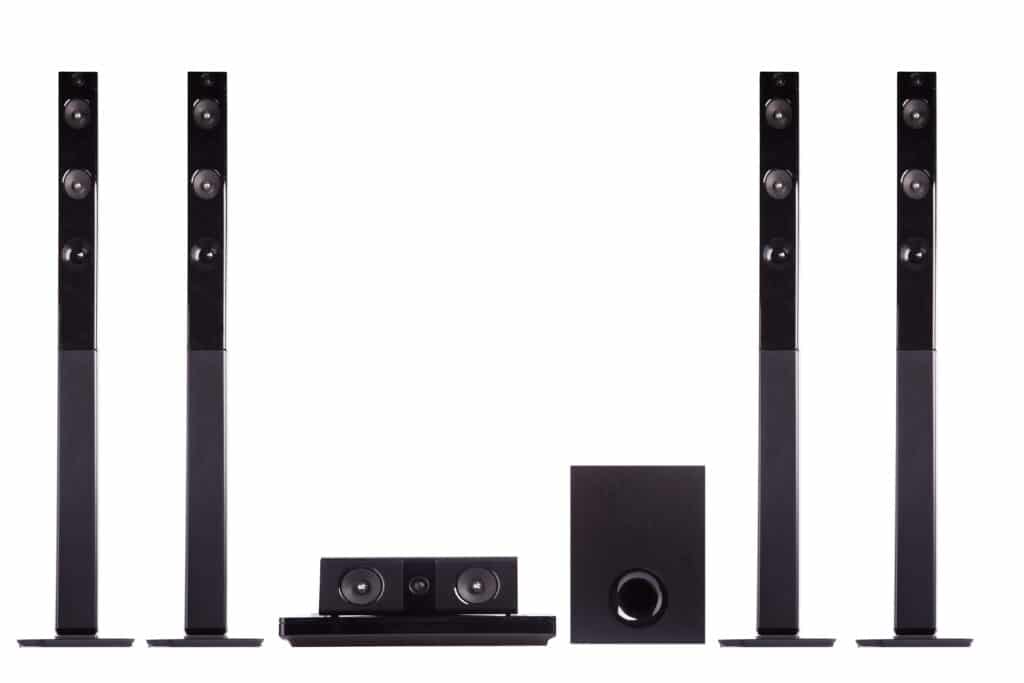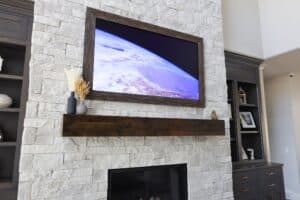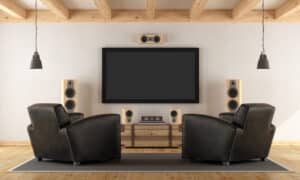Do you know what types of surround sound are available? If not, then this blog post is for you. We will explore the types of surround sound and see which one is best for your home theater system. You may have heard about 5.1 or 7.1 surround sound systems before, but do you really understand what they mean? In today’s article, we’ll learn exactly that!
Surround Sound Systems
When it comes to home theater systems, achieving true surround sound is essential. It enhances the viewing experience, making movies and TV shows more immersive and lifelike. However, designing your own surround sound setup can be a little complicated if you’re not familiar with it. You need to understand the various types of surround sound and the specific speakers required for each configuration. Factors such as room size, speaker placement, and system components all play an important role in creating the perfect home theater environment.
A typical surround sound system includes five main speakers and a subwoofer, delivering powerful bass. Known as “5.1” surround sound, this configuration consists of front left, front right, center, and two surround speakers, all designed to create an enveloping audio experience. The subwoofer, dedicated to low-frequency sounds, adds depth and richness to the overall soundscape.
Surround Sound Basic Components
The following are the main components of a typical surround sound speaker system.
Subwoofer
A subwoofer is a large, powerful speaker that creates bass tones and other low-frequency sounds. A subwoofer uses air pressure to generate a deep, rumbling sound that fills a space with bass. Subwoofers are usually placed in the corner of a room or theater for optimum impact.
Subwoofers are a simple way to improve any sound system. AIS provides the option of an extra subwoofer as an alternative. This would be placed opposite of the other, one in front and one in back or catty-corner from on another.
Center Speaker
The center speaker is the most important speaker in a surround sound system. It reproduces the dialogue from movies and TV shows, making it easy for you to understand what’s being said. The center speaker is typically the largest of all your speakers.
Satellite Speakers
A satellite speaker is a catch-all term for any of the speakers intended to be placed on the left or right sides of the room. These speakers usually provide midrange and high-frequency sounds.
Equalizer or Mixer
An equalizer or a mixer is used to adjust the sound from each speaker. You can use an equalizer to create different effects, such as making certain types of music louder than others.
Types of Surround Sound Systems
5.1, 6.1, and 7.1 channel surround sound are the three most common surround sound systems. The numbers represent the number of speakers required for that type of surround sound system.
The first digit of a speaker system configuration denotes the number of main speakers in the system. When it comes to primary speakers, we’re talking about the front left, front right, center, and various surround speakers. The second number is the total number of subwoofers. Other combinations that you may encounter include 7.2, which means seven speakers and two subs.
What is 5.1 surround sound?
As mentioned before, a 5.1 surround sound also known as Left Center Right (LCR), refers to a speaker system that includes five main speakers with two in the back. This is the most common type of surround sound used in home theater systems.
The three primary speakers (LCR) are typically placed in the front of the room, while the other two speakers and subwoofer are usually positioned in a corner. The five speakers are responsible for reproducing the majority of the sound, while the subwoofer creates low-frequency sounds that give movies and TV shows a more immersive feeling.
5.1 surround sound is a multichannel audio technology that makes use of the six-channel surround technique. This approach uses five full-bandwidth channels with frequencies ranging from 3 to 20,000 hertz.
What is 7.1 surround sound?
A surround sound system with seven speakers is also a multi-channel audio configuration. However, the addition of two rear surrounds means that it can be more accurate than a five-speaker setup.
The additional back speakers make it possible to determine where sounds are coming from in relation to your position and they’re supposed to create an even more realistic surround sound experience.
A seven-speaker surround sound setup, similar to the five-speaker configuration, uses a subwoofer to handle low-frequency audio. The notable difference is the addition of two extra speakers, providing more detailed and dynamic sound distribution. This setup is often referred to as “7.1” surround sound, where the seven speakers and one subwoofer work together to create a balanced and immersive sound experience. By spreading the low frequencies across two channels, this setup enhances the spatial accuracy of audio effects, making your home theater experience more realistic and enjoyable.
In general, most people feel that a seven-speaker surround sound system delivers superior sound quality to five-channel setups. However, this isn’t always the case, and it all depends on your specific needs as well as how many speakers you’re willing to buy.
5.1 vs 7.1: What’s the Difference?
The most significant distinction between a five-speaker and a seven-speaker surround sound system is that 7.1 generally incorporates LCR speakers on the sides and rear, with two in each direction. These are placed at the back of the room, directly opposite the front speakers. The purpose of these extra surrounds is to create an even more immersive experience by providing wraparound sound.
Some people also find that a seven-speaker system gives them more accurate sound localization. This means that you can better determine where sounds are coming from, making the experience even more realistic.
What other types of sound system formats are there?
Aside from the two most common systems there are a few other home theater speaker setups to consider including but not limited to:
2.1 Speaker System
This is the simplest and most common type of surround sound. It uses two main speakers and a subwoofer to create a surround sound experience.
This setup is great for people who don’t want or need all the bells and whistles that come with a more complex system. It’s also perfect for small rooms since it doesn’t require as many speakers.
6.1 Channel Surround
One of these is a six-speaker surround sound system, which includes three front speakers and three surround speakers. This is an affordable way to get into surround sound, but you won’t experience the same level of immersion that a seven-speaker system offers.
When compared to a 5.1 channel surround sound system, a 6.1-channel surround sound system provides somewhat more enveloping surround sound effect because there is one additional discrete center channel in the rear of the room.
9.1 Surround Sound System
The final type of surround sound that we’ll mention is the nine-speaker system. This configuration includes four front speakers, four surrounds, and one subwoofer.
In this case, the addition of four surround speakers provides a more immersive sound experience. However, it’s important to note that nine-speaker setups can be quite expensive and not everyone has enough space for them.
9.2 Surround System
9.2 is a popular choice with LCR 2-4 on the sides and 2-4 in the back, depending on the room’s shape. A 9.4.2 is popular among those who are serious about home theater.
Next-Gen Audio: Dolby vs DTS
Adding object-based audio, like Dolby surround sound can further enhance your home theater experience. Object-based audio format places sound in more specific locations around the room. There are two main options for this technology: Dolby and DTS. Moreover, both types of sound offer impressive performance and they help to make your movies, TV shows, and video games more realistic.
Dolby
Dolby Digital is a trademark used by Dolby Laboratories for audio compression technologies developed by the company over many years. This technology makes it possible to compress digital data without compromising its quality so that you can store more information on a DVD or stream it faster over the internet.
The Dolby TrueHD codec delivers lossless audio that’s on par with the company’s high-end sound formats. It also supports up to eight channels at 192 kHz and features eight discrete channels of sound.
Furthermore, Dolby Digital Plus is a newer codec that offers even better performance than the older Dolby Digital format. In fact, Dolby Digital Plus supports up to seven channels at 192 kHz and includes features like dynamic range control and dialog enhancement.
Dolby Atmos
Dolby Atmos is used with these systems to enhance them further. With Dolby Atmos, sound can be placed into a three-dimensional space so that it feels like it’s coming from all around you. This technology is becoming more and more common in both movies and video games.
DTS
DTS is another popular surround sound system that’s found on many types of media players and disc formats such as DVDs, Blu-rays, UHD (Ultra HD) BDs, and so on.
This technology is designed to improve the standard of surround sound experience by giving you more freedom with how your speakers are set up and where they’re placed in a room.
In terms of sound quality, the DTS codec is largely comparable to Dolby TrueHD. It offers a higher bitrate, which means that you can enjoy a more immersive sound. It supports a maximum of eight channels and playback at either 24 or 48 bits per second.
Moreover, DTS-HD Master Audio is a high-resolution version of the DTS surround sound system. It delivers lossless HD audio and provides up to eight channels at 96 kHz/24 bit, which is perfect for Blu-ray movies.
However, DTS: X is a newer codec that provides even better sound quality than DTS HD Master Audio. While it doesn’t support quite as many channels, DTS: X can playback sound at 96 kHz/24 bit for up to 11.
Choosing a Surround Sound Setup for Your Home Theater
If you’re looking to buy surround sound speakers, there are some key factors that you’ll want to consider. This includes the size of your room and types of media that you plan on using with it.
For example, if all the TVs in your house have small screens or people don’t watch TV very often then buying more speakers than you need can be a waste of money. On the other hand, if you have more than one TV or commonly watch movies in your family room then it might make sense to go with something larger and more elaborate.
Factors to Consider
There are also some key constraints that people may face when buying surround sound systems such as limited space for speakers or budget limitations.
In the end, it’s important to think about what you want and need from a surround sound system before making your purchase. This will help ensure that you’re getting the most value for your money.
Other factors to consider include:
- The types of media you plan on using;
- The size of your room;
- Speaker layout;
- How many people will be using the system simultaneously;
- The types of systems that you’re interested in along with their price ranges;
Overall, when it comes to surround sound, there are plenty of options to choose from. It all depends on your specific needs and what you’re willing to spend. By understanding the different types available, you can make a more informed decision about which system is right for you.
Different Types of Speakers
When deciding on a surround sound system, you’ll also need to decide on the types of speakers that you want. This includes the number and types of speakers as well as their location in your room.
Tallboy Speakers
Tallboy height speakers, also known as upright or freestanding speakers, are typically larger than other surround sound speakers and they’re designed to be placed on the floor.
They can provide a more immersive experience by adding height to the soundstage, which gives you the feeling that the action is happening all around you. For example, the Sony 5.1ch Home Cinema Soundbar System with Tallboy Speakers is a great option if you’re looking for something that’s easy to set up and doesn’t require a lot of space.
Compact Speakers
If you don’t have much space, then compact speakers are a good option.
They take up less room, but they also require more components to provide the same surround sound effects as larger types of speakers.
Bookshelf Speakers
Bookshelf speakers are smaller than floor standing models, but they offer good sound quality and can be placed on a bookshelf or other piece of furniture.
Wall-mounted Speakers
Wall-mounted speakers are a good option for people with limited space. They can be placed on the wall above your TV or in other areas that have enough room to accommodate them. For instance, Sonance Professional Series 6.5″ Surface Mount Speaker is a great option if you want to use wall-mounted speakers.
In-Ceiling & In-Wall Speakers
In-ceiling speakers are an excellent choice for people who want to have a surround sound without taking up any additional space.
They can be installed in the ceiling of your room, which helps to diffuse the sound and create an immersive experience.
Sound Bars / Speaker Systems
Sound bars are a type of speaker system that’s designed to be placed in front of your TV.
They’re a good option if you don’t have a lot of space or if you want something that’s easy to set up. In addition, sound bars often include multiple speakers and subwoofers which can provide better sound quality than a standalone speaker.
Subwoofers (aka, Bass)
If you want deeper, more immersive sound effects then a subwoofer is the way to go.
A good subwoofer will help you hear all types of sounds including explosions and other dramatic special effects in your favorite movies or TV shows. Brands like James Loudspeaker’s subwoofers are known for their quality and bass that will shake your room.
Last but not least, in-wall and in-ceiling speakers come in many shapes and sizes. These speakers provide an alternative for those who want to be inconspicuous. They are muddled into the sheetrock, virtually invisible.
Need help designing surround sound for your Utah home theater?
And that’s it! We hope this article has helped you understand the different types of surround sounds available and what might be best for your home theater setup.
If you’re looking to upgrade your Utah home theater sound system, we can help. Contact AIS today to design a surround sound system that will take your home theater experience to the next level!




